Word came on 28 January 2013 that a well-known band of Cree Natives was throwing its support behind Idle No More, the Canadian Native protest movement. Members of the Lubicon Nation had set up ‘information checkpoints’ on a highway that cut through their traditional land in Northern Alberta.
The protest brought back some vivid memories of a much stronger show of force by the Lubicon in the fall of 1988 when the small band tried to exert sovereignty over its ancestral territory of 10,000 square kilometres.
The stand-off — Natives and their supporters on one side, police on the other — became an international news story.
People were drawn to the story because it had a ‘David & Goliath’ feel to it: A small group of Indians [500] living in near-isolation, fighting to protect their land and livelihood against two formidable opponents: Big Industry and Big Government.
Make that three. Police weighed in on the side of Goliath, and they did that so that consumers would have unrestricted access to natural resources.
The protest shut down all oil and gas activity in the area. Not good for Big Business.
Long before the first European settlers arrived in what is now Canada, the Lubicon Cree lived in the bush in a remote part of North-central Alberta.
They got few visitors, which didn’t bother them too much. The band was self-sufficient.
Things started to go sideways for the Lubicon in the 1950s after vast deposits of oil and gas were discovered in their backyard.
Resource extraction began in 1979. Within three years, the Lubicon found themselves surrounded by about 400 oil and gas wells. That’s not a misprint. 400. To make matters worse, the highly toxic gas sometimes leaked, poisoning both the locals and their water supply.
Massive resource development did not make the Lubicon wealthy. Quite the opposite. As a result, something else developed on the Lubicon traditional territory: conflict.
As a reporter with the Canadian Broadcasting Corporation [CBC] covering the Lubicon story in the 1980s, I made some key discoveries of my own — discoveries about treaties, government and the police, the resource industry … and my own industry, the news media.
This post is largely about those light bulb moments …
October 24, 2018 … “This just in …” A major development in the Lubicon Cree story … a settlement has finally been reached with the Lubicon Nation, The Alberta Government and the Federal Government. For details, go to this Edmonton Journal story:
CHANGING PERSPECTIVES
Allow me to back up to the late 1970s, when I was an announcer at a private radio station in Edmonton, Alberta. At the time, CFRN-FM, 100.3 [now called The Bear] played easy-listening music and broadcast a series of interviews. My duties included interviewing book authors and other “notables.”
An Indian Chief from British Columbia [and be damned if I remember his name] dropped by our studios and pointed out something that threw me for a loop: Much of British Columbia, he said, was land the Indians had not given up. I shot back, “What the hell are you talking about?”
The Chief calmly explained that most Indian bands in B.C. had not signed treaties and therefore, he said, they hadn’t given up title to their land. In other words, the Natives felt they were still the rightful owners. It was as simple and as complicated as that.
As a person of French and English heritage raised and educated in Eastern Canada, average intelligence, traveled, etc … I was, well, stunned. This was a real head-shaker. The information seemed factual enough, yet totally absurd. It wasn’t that I didn’t believe the Chief; I didn’t want to believe him.
It made me wonder why I hadn’t been taught that in school. No teacher ever showed us a map of British Columbia and said, “by the way …” Come to think of it, no teacher ever told us about the ethnic cleansing of the Beothuks — the aboriginals of Newfoundland and Labrador — by European settlers. The weaker Natives were hunted down and murdered for sport. The Beothuks were eventually exterminated. A Canadian version of genocide.
I give full credit to CFRN-FM for not censoring the chief’s interview. The man said his peace, he bid me farewell and the interview went to air as is. It was one of my first experiences of ‘in-your-face’ journalism.
I can’t speak for our listeners, but what our guest talked about that day hit me between the eyes. From time to time, his words tugged at my conscience … especially when I was driving in British Columbia and came across signs that reminded me I was entering Native territory.
TREATIES SIGNED — BUT LUBICON MISSED
In 1899, Indians living in what is now northern Alberta signed a deal with the federal government. The Lubicon Cree were not part of the agreement, called Treaty 8. It wasn’t that the Lubicon had shunned it; they simply didn’t know about it.
The small band was left out of the whole Treaty 8 process because the treaty commissioners — who traveled up and down the Peace River, signing up Indian bands along the way — didn’t trek 100 kilometers east and ask the Lubicon if they wanted in on the action.
I’m not sure if the treaty commissioners were ignorant or lazy, although I suppose it doesn’t really matter anymore.
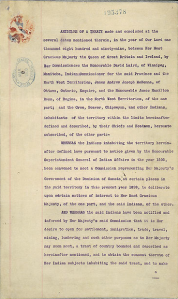
Page 1 of Treaty 8 For more on Treaty 8 including a typed transcript — click on: http://www.aadnc-aandc.gc.ca/eng/1100100028813/1100100028853
The Canadian Government has long recognized Indian bands as separate nations and of course treaties can only be signed between nations.
But why a treaty with the Indians anyway? The idea was that Canada’s aboriginals would get a piece of land to call their very own, plus benefits such as health care, education, hunting rights, a $5 a year payment … and a small house.
In return, the Indians gave the government rights to their larger, traditional territory.
At the time, the Lubicon were not terribly worried they didn’t have a treaty. Life went on, treaty or no treaty. Just as they had for centuries, the Lubicon Cree raised their own food [much of it by hunting and trapping], raised families and lived and died.
But unlike Indian bands along the Peace River, the Lubicon had not ceded their territory. For that matter, the Lubicon hadn’t lost their land in a battle or in a poker game either.
When officials with the federal government finally got around to check out the Lubicon Cree, in 1939, they discovered the group was not connected to any band that had signed on to Treaty 8.
In those days, the Lubicon had little contact with the outside world. They had trap-lines and lived in sod-covered log cabins with no running water, indoor plumbing, electricity, telephones or radios. They got around with horse-drawn wagons and dog sleds.
The officials came to the conclusion the Lubicon were autonomous, a separate society with their own language, leadership, community, religion, sustainable economy and so on.
The feds did a head count and promised the Lubicon a reserve, plus the usual benefits. The Indians were also told that a Dominion crown surveyor would soon arrive to mark out their reserve. But after two failed attempts — and the fact that World War Two was now in full swing — that pledge was put on the back burner. The Liberal government of William Lyon Mackenzie King had more important things to worry about.
Also, talk was cheap. The Lubicon “issue” remained on the back burner for decades. And it stayed there long after the burner had been turned off.
In the 1970s, the primary mode of transportation were horse-drawn wagons. The trail from Peace River was a winding, single land wagon trail impassable by truck much of the year. The school bus was an enclosed horse-drawn wagon with a small wood-burning stove.
In the late 1970s, things began to spiral out of control for the small band. A road was built, mainly to provide access to resource companies. Before the Indians knew it, unwanted visitors showed up — with heavy equipment. Bulldozers plowed down trees and dug up the soil to make way for things like oil pump-jacks, pumping stations, pipelines, flare stacks, service roads and living accommodations for oil and gas workers.
Within just a few years, the Lubicon’s traditional territory had turned into an enormous industrial park with roads and pipelines running here and there. Hissing gas flares, scores of them, lit up the night sky.
In the name of progress, bulldozers also destroyed Indian trap-lines and an old burial ground. The trap-lines didn’t really matter because the animals had already fled the area. As for the burial grounds, well the people were dead anyway.
The Lubicon wondered what was going on. And so they asked the oil and gas companies, “Who gave you the right to take our resources?” “The Alberta Government,” they replied. The Indians asked the Alberta Government, “how did you get that authority?” “The federal government gave it to us,” they said. Those aren’t exact quotes, but you get the picture.
In 1930 Ottawa “decreed” the Lubicon’s traditional territory to be Crown land. That was news to the Lubicon Cree Nation — even decades later. News must have travelled a lot slower back then.
Since the Lubicon hadn’t given up title to their land, they felt that neither the provincial nor federal governments had any business passing it off to anyone.
Native support groups saw things the same way. But not so with the government and the oil and gas companies; they saw it as business. It had nothing to do with ethics, morals or historical agreements — and everything to do with money.
With their traditional way of life and economy busted, 95 percent of Lubicon ended up on welfare. That is not a typo. 95 percent is higher than the jobless rate in Newfoundland and Detroit put together.
Not surprisingly, the Lubicon Cree Nation began to fall apart. Because of poisonous gas leaks, they struggled with a shocking increase in stillbirths [within a year and a half, of the 21 pregnancies at Little Buffalo, 19 were stillbirths]. Too many one-foot graves. A third of the band members contracted tuberculosis. Asthma was widespread and children suffered from rashes so bad they became permanently scarred.
The average annual income for Lubicon trappers plunged from $5,000 to $400, a drop of more than 90 percent.
The Lubicon were humiliated and degraded. And with no work and nothing to do with their time, some band members made the mistake of turning to booze, with disastrous consequences. Suicides followed.
None of that shit happened before the onset of massive oil and gas development in Lubicon territory.
Even though their economy had collapsed, a huge majority of the Lubicon people stayed put, though a few did drift away to places like Peace River and Edmonton.
The fact that the Lubicon lived in poverty was ironic because of the value of the oil and gas taken from their land.
[A conservative estimate is that at least fifteen billion dollars’ worth of resources have now been extracted from the Lubicon’s traditional territory. The actual figure may be higher. 15 billion is still one pile of dough. Put another way, that’s more than $400 for every man, woman and child in Canada. What’s more mind-boggling is the total amount of royalty money held in trust for the Lubicon Nation: Zero. That’s right. For all the resources under their feet, the original inhabitants got zip.]
Things didn’t look good for the small band.
The Lubicon were fully aware the judicial system was biased in favour of those with power and money. In 1977, they learned a valuable lesson on how the system really worked. Knowing that construction of an all-weather road to their traditional territory would allow for massive resource development, the Lubicon Nation filed a caveat to stop the road from being built.
The Alberta Conservative Government [under Peter Lougheed] refused to file the caveat, however. The government asked the courts for a postponement and got one. It was nothing but a stall tactic. In March 1977, Conservative members of the Alberta Legislature amended the Land Titles Act — and did it retroactively. The new legislation [Bill 29] effectively killed the Lubicon court action.
In a move that redefined governance and sleaze, the Alberta Government borrowed a tactic used by Nazi Germany: rewrite laws to suit their purpose.
The road was built and the oil and gas companies moved in — en masse. The Lubicon Cree were now desperate. Not only were the Indians on social assistance, they were also dependent on the government to protect their rights — the same government that had been jerking them around.
Understandably, the Lubicon wanted the news media to do stories on their plight.
MY REPORTING OF LUBICON CONFLICT
While working as a reporter with CBC Radio in Edmonton in the mid-1980s, I got a phone call from Sunday Morning, the national CBC Radio newsmagazine program based in Toronto. Sunday Morning wanted an item on the Lubicon, and it wanted it yesterday.
The small Cree band had become a going concern, and it was all because of an influential newspaper in the United States. The New York Times published an in-depth, blow-out piece on the small Alberta Indian band, scooping — embarrassing, actually — the Alberta media.
It was a scoop by default. The New York Times and the Alberta media had been given the same material at the same time, but the locals chose to sit on it. That back burner was sure getting crowded.
Author in the office of the Lubicon Cree.
I accepted the Sunday Morning assignment, caught a flight to Peace River, rented a new half-ton truck and headed down a dusty road [Highway 986] for a one-hour drive to the home of the Lubicon.
Glistening no more, my vehicle came to a stop outside the small band office in the hamlet of Little Buffalo. I was a tad late for an appointment with Lubicon Chief Bernard Ominayak, whom I’d never met.
When I stepped out of the truck I was met by a young Native fellow, in his mid to late teens I reckoned. The kid, who wore an old baseball cap, was an inquisitive sort who peppered me with questions about my half-ton. I didn’t want to ignore the guy and hurt his feelings — but I did have an appointment with the Chief and time was marching on.
Finally, I said, “Sorry bud, I really don’t have time to talk because I’m meeting with Chief Ominayak.” I figured that by dropping the Chief’s name, he’d get lost and I could get on with business.
“Know where I can find him?” I asked. The kid looked up and in a soft voice said, “You’re looking at him.” A smile broke over Bernard Ominayak’s face and we shook hands.
‘DISPUTED TERRITORY’
And so began my working relationship with Chief Ominayak and the Lubicon Cree. Over the next day or so I recorded interviews and all kinds of sound effects. [Sunday Morning was big on sound effects] I flew back to Edmonton and put together the mini-doc Toronto wanted. After Sunday Morning threw in more sound effects of its own, the program on the Lubicon went to air.
After that, I followed every development in the Lubicon saga. And I mean every development. I found out when top government officials flew in for secret meetings, what Lubicon support groups in Europe had lined up … and tweaks the government made to its offers.
Some reporters get information from sources; others get information from news releases. We can either go straight to the source or wait by the fax machine. I worked hard to develop contacts with both the Lubicon and Federal Indian and Northern Affairs.
If you were a listener of CBC Radio News in the 1980s, you would have heard my reports on CBC National News, World Report and The World at Six.
I also began using the phrase ‘disputed territory’ when describing the Lubicon’s traditional area, because I felt the term was neutral. This was not a ‘land claim’ but a jurisdictional dispute. However, not everyone at CBC Radio in Edmonton thought the same way. A morning editor once cut out ‘disputed territory’ from one of my reports. I asked why. Her answer was that it was to “save time.” Save her ass was more like it.
I persisted in describing the disputed area as ‘disputed’ and the censorship stopped, in part because other media outlets — including the Edmonton Sun — started using the term as well.
Lubicon Children
Another descriptive term I tried very hard not to use in my stories was ‘land claim.’ I thought it was loaded and unfair to the aboriginal people. ‘Land claim’ is and always has been government propaganda.
I continued to do regular reports on the Lubicon file, which eventually culminated in the much-publicized protest in October 1988. The Lubicon action became known by the public as a “barricade” and by the Lubicon people as “an assertion of sovereignty and Native rights.”
Days before the Lubicon strung ropes across roads, the oil and gas workers had turned off their equipment, installed padlocks and cleared out.
The RCMP showed up at Chief Ominayk’s office, saying they were there to protect property. “I’m glad you’re here,” said the Chief, “because somebody has been ripping up our traplines.”
FOREIGN MEDIA AT LITTLE BUFFALO
More than a dozen reporters then moved in to cover the story. Most were from Canada; some were from the U.S. and Europe. Heck, the story was so big that a private radio station in Peace River [100 kilometers away] actually sent out a reporter to cover it.
Giampaolo Pioli, a journalist working with an Italian news organization, made an impression because he didn’t follow the pack. Giampaolo was an original. While most reporters milled about the band office looking for quotes and releases, he often struck out on his own, walking about Little Buffalo and taking everything in.
I once caught up with Giampaolo in the small graveyard in Little Buffalo where he was trying to read faded names and dates on some old wooden crosses. He turned and said, “Many died young.” Giampaolo’s observation shamed me because it was my second trip to Little Buffalo and I hadn’t checked out the graveyard.
Turns out, there were a lot of things I hadn’t noticed.
The Italian went on to say that the shacks in Little Buffalo were a world apart from the nice houses he’d seen in Edmonton and Peace River. He, like others, described the home of the Lubicon as having Third-World living conditions. Giampaolo added that people in Italy would find it hard to believe there were actually places like that in a modern country like Canada.
HURRY UP AND WAIT
I made regular sorties to the various checkpoints, some of them deep in the forest. I wanted to see if anything was happening, perhaps snag an interview clip or two. There was an understanding among those manning the checkpoints that police would strike. It wasn’t a question of if, but when. And because of that, there was always tension at the checkpoints.
Every night I went to bed with the same thought pin-balling in my head: will tomorrow be the day?
It turned out to be a nervous waiting game, and some of the reporters became restless. After a few days of peace and quiet, a reporter with one of the eastern newspapers paced back and forth outside the band office, mumbling that he wanted “some shooting.” What he was really saying was that he wanted something to happen. I mean, there are only so many feature stories a reporter in the field can file; sooner or later an editor is going to ask, is anything substantial going on, otherwise pack your bags and get out.
The longer the stand-off dragged on, the faster the number of reporters covering it dropped.
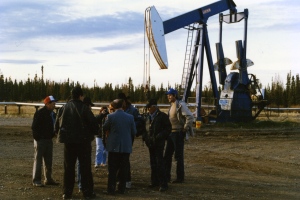
Chief Bernard Ominayak is surrounded by band members, reporters and lawyer James O’Reilly near a pump jack that has been turned off. I’m the tall dude on the right.
THIS JUST IN FROM LITTLE BUFFALO
Journalists were constantly looking for scoops, nuggets or a different angle to the story.
One interesting sidebar: two hunters from the Edmonton area approached a Lubicon checkpoint. The men paid $5 or $10 [can’t remember the figure now] for a permit to enter Lubicon territory. I believe it was the only permit sold during the conflict. Can’t say if the hunters got any game, but they sure snagged a bit of history.
My cruiser at one of the Lubicon checkpoints
Late one evening I drove my cruiser in the direction of the northernmost checkpoint. I stopped in the middle of nowhere, killed the motor and rolled down my window. Everything was natural and very peaceful. The air was remarkably fresh; gone was the stench from the oil flares.
There were also a million stars in the sky. I could even see stars on the horizon, poking through the tall evergreen trees. Because of pollution, we folk living in the city don’t get to see natural wonders like that.
I filed a light story, okay a fluff piece, on what I’d seen that night. Next morning there was some gentle kidding from one of the Lubicon lawyers, James O’Reilly, who heard the report on CBC Radio. “Waxing poetry, are we Mr. Christopher …?”
O’Reilly, a prominent Montreal lawyer, gained national recognition in the 1970s when he negotiated an historic settlement on behalf of the Cree Indians of James Bay, Quebec.
Byron Christopher and Chief Bernard Ominayak
The Lubicon kept track of what the media were doing, posting our stories on a wall in their grocery store, near the band office. In no time at all, the walls were plastered with stories from many news organizations. It was interesting to see the different treatment various news companies gave the story.
JOURNALISTS, OTHERS IN THE THICK OF THINGS
Most journalists stayed at hotels in Peace River. Every morning they made the trip out to Little Buffalo to get material; by mid to late-afternoon they were heading back to Peace River again.
I had a room in a small house in Little Buffalo, the same house where James O’Reilly was staying.
O’Reilly’s bed was an old sleeping bag spread out on the living room floor, close to the wood-burning stove. I recall him waking up one morning — stretching his arms high in the air — and proclaiming it was a great day for the Lubicon Nation [‘dawn of a new era’ or something like that, in any case, kinda dramatic stuff]. Someone yelled out, “Jim, it’s your turn to put wood on the fire …”
Staying at the house, as well, was John Goddard of The Canadian Press. John later wrote a book called Last Stand of the Lubicon Cree. The book sold well … about 6,000 copies, both hardcover and paperback. John also did a lengthy piece for a top magazine at the time, Saturday Night.
Three other journalists stayed in the area as well, including award-winning reporter Mark Lowey and photojournalist Tom Walker of the Calgary Herald.
Tom parked his small trailer in the wide, shallow ditch alongside the main barricade, a few kilometers west of Little Buffalo. It was a brilliant move because the guys were jolly on the spot when the police came knocking. Mark and Tom gave their readers a front row seat to one of the biggest news stories in North America.
Don Thomas of the Edmonton Journal stayed nearby, in one of the housing units vacated by oil workers. Don, an outdoorsy type, did a fair amount of reporting on the Lubicon.
Another news conference at Little Buffalo, another gathering of reporters.
Supporters from various religious organizations, including the Mennonite and Catholic Churches, made their way to the front lines at Little Buffalo. I found these people to be not only “on the ground,” but grounded as well. They reminded me of a tough, cigarette-smoking Roman Catholic Nun I interviewed during the revolution in Nicaragua, Central America, nearly two decades before. That gal had integrity and guts.
The sense I got is these people walked with Jesus. Strange for me to say that, but there you go.
The religious visitors at Little Buffalo weren’t just drawn to the excitement of a stand-off. They also appeared at public forms, rallies and boycotts and took part in letter-writing campaigns. And because they spoke with conviction, they gave great interviews — although one woman complained after I described her in a news story as “old.” Now that I’m past the age she was back then, I kinda see her point.
ONE MAN’S REFLECTIONS …
The Lubicon barricade had tremendous impact. On some days, it was lead news story in the country. The ripples could be felt clear across the land, especially by those with a social conscience.
Kevin Flaherty took a few days off from his job at the Edmonton Learner Centre and travelled to Little Buffalo with his 3-year-old daughter. They ended up sleeping in Kevin’s Dodge Colt.
“I collected fond memories,” Flaherty recalls, “memories of some fine people dealing with a shitty, shitty deal. There was tension in the air. I remember visiting the checkpoints and sharing time with folk, the hard-working women sharing sandwiches and all of the other stuff that made up our days.”
“Great memories of the best of things when good people get together to do good things.”
VISITING POLITICIANS
Politicians — both Native and non-Native — came and went during the stand-off. Some travelled from as far as Europe, where the conflict had gained some notoriety. Mind you, the Germans are especially interested in North American Indian stories because of a popular fiction book by Karl May, written about 100 years ago, about a noble and wise American Indian Chief called Winnotou.
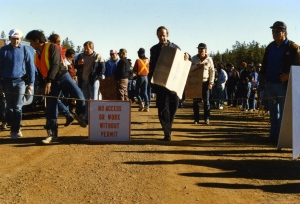
Herman Verbeek, Member of the European Parliament, carries a sign at the main checkpoint.
One of the Native politicians I ran into at Little Buffalo was Chief Billy Two Rivers from Quebec. Two Rivers, a former professional wrestler, used a descriptive phrase I hadn’t heard before: “Dominant society.”
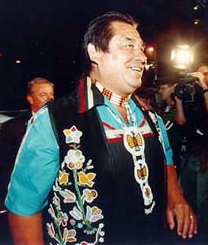
Chief Bill Two Rivers [photo courtesy of Wikipedia]
All in all, the Lubicon action was peaceful — very Canadian, if you will.
EVE OF THE RCMP RAID
The night before the Mounties arrived, David Kirkham, Acting Senior Editor of CBC Radio News in Edmonton, asked if I should pull out of Little Buffalo since not much seemed to be going on. Besides, David pointed out, I was sounding tired in my reports. I told him that I was beat, but my gut feeling was to hang in for at least another day. David said, “it’s your call.” I decided to stay.
Only hours earlier, I’d passed through the Lubicon checkpoint on my way to Peace River — only to be stopped about a kilometer down the road at another checkpoint, this one manned by the RCMP. A Mountie wanted to chat and so I rolled down my window. It was the sergeant in charge, and he asked if the Lubicon had any high-powered rifles [as if I would share that information even if I did have it]. The officer may have mistaken me for one of those in the media who raise money for the police.
The sergeant also wanted to know if I was returning to Little Buffalo, and I told him I was. I was waved through.
The Lubicon checkpoint and the RCMP checkpoint [in the distance].
My sense was that something big was coming down, and soon. I picked up a few supplies in Peace River and scooted back to Little Buffalo.
After I returned, a worried-looking Chief Ominayak approached as I sat in my car writing reports. He asked if I was going to stay, and I told him I was. I said, “why do you ask?” The Chief smiled and said, “Thank you.”
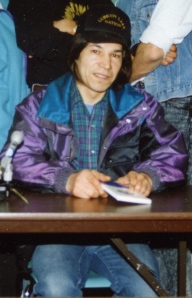
Chief Bernard Ominayak of the Lubicon Cree. [Photo by Author when Ominayak came by Grant MacEwan College in Edmonton where I was teaching journalism]
THE RCMP RAID
After five days the Lubicon protest was smashed by the Royal Canadian Mounted Police. The Mounties didn’t come to Little Buffalo to protect the rights of the Lubicon; they came to get the oil and gas flowing again. The Mounties were following orders.
On the morning of the raid, I was sound asleep when an Lubicon Indian burst into my room and shouted, “Police are here!” There would be no breakfast over a wood-burning stove that day. There was also no time to shave. Hell, I hardly had time to take a piss.
I slipped into my blue jeans, put on a sweater and ran to my cruiser, parked just outside the door. While the car warmed up, I worked like a mad man to scrape the frost off the windshield.
It was still dark as I tore off down Highway 986, my car fish-tailing from side to side on the snow-covered road. I could clearly see the main checkpoint about a kilometre away because of the flashing lights from all the RCMP vehicles.
A lone police helicopter was making sweeps above the trees.
Dressed in camouflaged uniforms, police sharpshooters took positions in the forest, sporting high-powered rifles with scopes on them. In their crosshairs were the protestors. No shots were fired that I was aware of.
The Mounties had attack dogs as well.
BREAKING NEWS!
I pulled up on the wrong side of the road, turned off the engine and frantically phoned CBC Radio’s Edmonton AM with the breaking news.
I’d just connected with Edmonton when a Mountie appeared out of nowhere and tapped his flashlight on my driver’s side window. “Move it,” he said, “you’re on the wrong side of the road!” I explained I couldn’t fire up my engine because I’d then lose phone contact with Edmonton. The officer didn’t know what to do, so he stared at me for a moment, then said, “yeah, okay …” and left. He did not return.
Because of the deafening noise from the chopper, I could not hear a damn word Edmonton was saying. The pilot had decided to park his helicopter about 15 feet or so above my cruiser, likely because he spotted N E W S splashed in large blue letters across the white hood. The small vehicle shook violently from the chopper’s powerful wake.
I wasn’t afraid, just ticked. I couldn’t do my job.
Once a phone connection was established, Edmonton-AM went directly to air with the call. But again the noise made it impossible to hear anything at my end. I kept repeating, “Edmonton, do you read me? …” and John Grant, the show’s co-host, kept saying, “yes, Byron, we hear you … go ahead …”
For a while, all our audience heard was this tense exchange over the whop-whop-whop of a chopper. It was like a scene in a Vietnam War movie.
I had no choice but to break a cardinal rule of broadcasting: turn on the radio while transmitting a live report. That’s a no-no because of the screeching feedback. Turns out, the noise from the chopper was so loud it didn’t matter. There was no feedback. When I finally heard John’s voice coming over the speakers, I described the dramatic scene unfolding before my eyes.
I then heard the buzz of a chainsaw as police made quick work of the large wooden posts that supported the rope stretched across the road. Once the rope fell to the ground, police cars crept by my news cruiser on their way in to Little Buffalo.
And so ended the main Lubicon barricade/passport control checkpoint.
The police raid became breaking news across Canada. Here’s how it looked coming across the wire services of Broadcast News [Canadian Press].
Broadcast News [Canadian Press] wire copy
A recording of that broadcast was later used by a TV production company to begin a documentary on the Lubicon Cree shown on German television. I could not locate a copy of the original radio recording, otherwise I would have put it up on this site.
A second Mountie appeared at my door, but this guy wasn’t barking orders. It was a good friend from my hometown in New Brunswick. Small world. He leaned over and asked, “Are you okay, Byron?” We shook hands and I said, “Fine, you?” “Okay,” he said. I asked, “when did you guys get the word to move in?” “Yesterday,” he revealed, “we were bussed in from K-Division [in Edmonton] …” The officer then tipped his cap and slipped away into the darkness. We both went back to work.
ARRESTS
The Mounties rounded up more than two dozen Lubicons and their supporters that morning, put them in paddy wagons and sped down the highway to RCMP holding cells in Peace River. Before that happened, I got out of my cruiser and sprinted to where the prisoners were held. My running caused some police attack dogs, restrained behind steel mesh in a van, to lunge towards me, teeth bared. Those dogs were mean.
Tom Walker of the Herald was busy snapping what turned out to be very exclusive photos. There’s nothing like being a journalist and having what no one else has but desperately wants.
News bulletins of the RCMP’s early-morning raid shot across Canada like a bullet. Soon everyone knew what had happened — including reporters enjoying their breakfasts in restaurants in Peace River. They immediately put down their cutlery, paid their bills and raced to the parking lot for a to-hell-with-the-speed-limit drive to Little Buffalo. They arrived in record time.
After the paddy wagons pulled out, I raced to Little Buffalo and burst into the band office. There was the Chief on the phone, tearing a strip off Alberta’s Premier, Don Getty. Ominayak accused Getty of getting the Mounties to do his dirty work. There I go, paraphrasing again. I believe the Chief may have uttered some cuss words.
THE SCENE AT LITTLE BUFFALO
RCMP cruisers were now all over Little Buffalo; some were parked, others were slowly cruising around. I began to scribble updated news stories for CBC Radio in Edmonton and for CBC National Radio News in Toronto. When I had the time, I answered questions from reporters working for TV and print outlets.
So much happened so fast that day. All the reporters working on the story put in long hours, snagging interviews and dealing with demanding editors back in their newsrooms.
PRISONERS RELEASED
After brief court appearances, the 27 people arrested were released late that evening. One was band advisor Fred Lennarson, a social scientist and civil-rights activist from Chicago.
“We want you all to agree to behave yourself and obey Canadian law,” I think is how it was put in court. Lennarson thought they’d be better off staying in jail [to make a statement]. The man in charge, Chief Ominayak, ordered them not to return to the lines and because of that, the protestors were released. As for the bit about obeying Canadian law, the Lubicon were of the opinion that in Lubicon territory, Canadian law didn’t apply.
The group returned to Little Buffalo late that night in a noisy convoy of cars and pick-ups. Horns blared as the convoy pulled into the dark hamlet. I gave a lift to one of the guys arrested [an Indian from British Columbia] on condition that I interview him as I drove.
It was a bizarre finish to one long, crazy day. For the reporters on scene, it meant more interviews and more reports to file.
The Lubicon saga was closely followed by thousands of Canadians, including a man in Manitoba serving time for murder. David Milgaard — later found to be wrongfully convicted — was so inspired by the stand of Chief Bernard Ominayak and the Lubicon that he hitch-hiked to northern Alberta in 1992, the year of his release from prison, to see the Chief.
Milgaard remains a strong supporter of the Lubicon Cree.
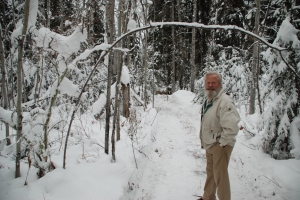
Wiebo Ludwig
Eco-activist Wiebo Ludwig of Hythe, Alberta traveled to Little Buffalo and met with Chief Bernard Ominayak. Ludwig offered to show the Indians how to build new homes, plant crops, use solar panels and so on. In other words, how to become more self-sufficient and less reliant on the government.
Nothing seems to have come of his offer. Ludwig died of cancer of the esophagus in April 2012. He too complained that his people were poisoned by sour gas leaks and that the authorities — including police — took no action against the gas companies.
SUDDENLY, SOME PROGRESS
Not long after the RCMP raid, the Lubicon Nation and the Alberta Government came to terms on the size of a new reserve and where it would be located — but the band and the Conservative Government of Canada [under Prime Minister Brian Mulroney] could not come to terms on a settlement agreement. Talks broke down not long after Mulroney was re-elected Prime Minister. Until then, negotiations had been making progress.
Ottawa then tabled to the Lubicon what it described as a “take it or leave it” offer. The Indians looked it over, said it was a bad deal and said, no thanks, we’ll leave it.
I once asked Chief Ominayak if they wanted to be reimbursed for the full value of resources taken from their traditional territory. He said they were asking for one tenth of the 20 percent the Alberta Government got in royalty money, which worked out to 2-pennies on the dollar. “What about the rest of the money?” I asked, “Who gets that?” His response was that it should be a gift to the people of Canada.
The Lubicon Indians were looking for money to rebuild their shattered economy. The band wanted things like a garage, a school and self-supporting agricultural land. The government essentially said ‘fuck you.’
Not long after, a U.N. Human Rights Committee in Vienna, Austria ruled that because Canada had mistreated the Lubicon, Canada was guilty of cultural genocide. The allegations gave Canada a black eye and, at the time, caused quite a stir. I broke that story too after being given a copy of the U.N. committee’s decision.
Chief Ominayak’s reaction was that Canada’s reputation as a nation that cares for its aboriginals was exposed to be a myth. An embarrassed federal government, meanwhile, blasted the U.N., especially for its use of the word genocide. For that matter, neither were the Lubicon totally happy with the U.N. decision. The Indians felt the world body was, in some ways, sitting on the fence.
The U.N. decision created quite a firestorm. Courtesy of the Lubicon Lake Nation, here is the Indians’ news release on the U.N. decision — along with some media coverage at the time.
http://www.lubicon.ca/pa/humanrp/lm900510.htm
DAISHOWA
A Japanese pulp and paper company then joined the many oil and gas firms working in the Lubicon’s traditional area. Daishowa went to work cutting down swaths of trees to supply its new mill near Peace River. Clear-cutting in the disputed territory led to protests in Japan and elsewhere … leading to more international coverage of the plight of the Lubicon Cree.
The Indians were faced with another myth: so much for respectable Japan.
The political skirmishing continued when the Alberta Government put up street signs throughout Little Buffalo as a way of telling the Indians they had now agreed to some sort of provincial jurisdiction. The Indians ripped the signs down. And with money and advice from the Canadian Government, a group of break-away Lubicon was suddenly given its own reserve just west of Little Buffalo — complete with new houses.
The good news for the Lubicon was that the Government of Canada could get a land settlement fast-tracked if it really wanted to.
BEHIND THE SCENES AT THE CBC
I continued to follow the Lubicon story, getting the odd scoop. When these stories were broadcast on CBC Radio National News, the Minister of Indian and Northern Affairs, coincidentally, would sometimes fly to Edmonton, hold a news conference and try to counter information in my reports. When it happened a third time, Dave Cooper, a veteran reporter in our newsroom, pointed out that our news reports were obviously influential if they dictated the schedule of a federal cabinet minister. I said, “Dave, this ain’t good …”
Much of the funding for the CBC of course comes from the Canadian Government. Indian and Northern Affairs was also funded by the Canadian Government.
Not long after, there was a meeting between CBC brass and senior officials of Indian and Northern Affairs, held in the main boardroom of the CBC Radio Building in south Edmonton. On the agenda was CBC’s coverage of the Lubicon Cree story. I was not invited to the meeting, didn’t even know about it until after it was over. I found out about the meeting from a contact at Indian and Northern Affairs.
It appeared that the government wanted me to stick to their press handouts. No one ever mentioned to me — from either side — that my reports were not factual. Ottawa just didn’t like the reports that were going out on CBC Radio. It wanted government propaganda, not news.
Ron Smith, Regional Director for the CBC, came around to my desk and suggested I do a news story on where the Lubicon Cree was getting its money. “Partly from church groups,” I told him. It was the only time I recall a Regional Director proposing a story. It wasn’t long after when the Senior Editor of CBC Radio News in Edmonton, James Wark, echoed Smith’s suggestion that I do a story on where the Lubicon was getting its money.
During the height of the Lubicon demonstration, I asked Ken Colby, a spokesman on contract for Indian and Northern Affairs, if the Lubicon Cree ever signed a treaty. The response from Colby, a former CBC reporter, was “Get your lawyers to talk to our lawyers.”
In 1993, one of the election promises by Federal Liberal Leader Jean Chretien was that his government would make sure that royalty money was put in a trust fund for the Lubicon Cree. After Chretien got elected, reporter David Kirkham asked Chretien about the trust fund. “I have a very good minister of Indian Affairs,” the Prime Minister responded, “why don’t you ask him?”
No trust fund was ever set up. It was all bullshit. If the Right Honourable Prime Minister had been hooked up to a lie detector he would have blown every gasket in the machine.
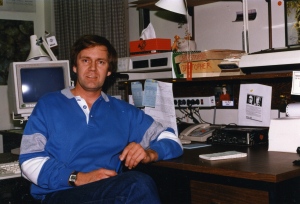
Author Byron Christopher at his desk in the CBC Radio Newsroom in Edmonton. [photo by Lydia Neufeld]
http://nisto.com/cree/lubicon/1991/19911116a.html
An angry listener once called the CBC Radio newsroom in Edmonton to complain the CBC was not providing enough coverage of the Lubicon story. After the listener hung up, the reporter who took the call announced, “What?? We are fucking Radio Lubicon!”
I did not agree with the caller. CBC Radio reporters did the best they could, often leading the way with coverage of that important story.
Lubicon advisor Fred Lennarson may have felt that way too, not sure. Lennarson phoned to predict that my days as a reporter on the Lubicon story were numbered. I called him paranoid. Lennarson then rattled off names of journalists who’d been covering the Lubicon story, as in past tense. Mysterious, negative things happened to their reporting careers. I knew those people; in fact was well aware of some of their difficulties. I just hadn’t connected the dots.
At that point, I decided to switch to a new beat — criminal justice — where I uncovered more crap.
Turns out, Fred Lennarson wasn’t paranoid; he just knew what was really going on with the news media.
Another discovery I made was that the Lubicon were not the only people in Alberta being poisoned by leaks from gas wells. Non-Natives were being fumigated too — and that Alberta farmers had their own land rights issues with intrusive high-voltage electricity towers, pump jacks and pipelines on their property. The Indians sure aren’t alone. They were only the weakest and most vulnerable.
Back to the Lubicon. How are they doing today? I believe that life for them is worse than before. I was up to Little Buffalo in 2012 or so and it didn’t look like a lot had changed.
Some say the Lubicon society has been torn to shreds. But hey, oil and gas is still relatively cheap … and a lot of people are making money.
THE ‘IDLE NO MORE’ MOVEMENT
There’s been a fair amount of media coverage — much of it social media — on the Idle No More movement. My thoughts on that are that Canada’s Native community is so fragmented I wonder if any good will come of it — not to take anything away from both Natives and Non-Natives who want positive change for the good of all.
It seems that the movement has polarized Canadians. Indians are more convinced than ever they’ve been screwed over.
Taxpayers feel the same way. They have a right to know where their hard-earned dollars are going. They say much of their money is being flushed down the toilet because of nepotism, greed and stupidity by Native leaders. The allegation is that band leaders and their cronies line their pockets while their people live in deplorable conditions.
And it sure doesn’t give the Idle No More movement credibility to see Chief Theresa Spence of the Attawapskat Reserve [near James Bay in northern Ontario] after 6-weeks of a “hunger strike” looking like she wouldn’t be out of place at a Jenny Craig meeting. Spence’s diet of fish broth and medicinal teas has spawned a number of jokes, now being circulated on the Internet. [Given her size after the hunger strike one joke has the U.N. using her fish broth to eliminate world hunger]. Ooops. Idol no more.
Canadians have a right to demand their tax dollars are not wasted. Fine. But accountability works both ways. There are some who say the value of natural resources taken from disputed territory far outnumbers money given to Natives. Writer Dru Oja Jay contends that when all the numbers are crunched, it’s the Canadian Government that is being subsidized, not the Natives.
![The United Nations Secretariat Building in New York [photo courtesy of Wikipedia]](https://byronchristopher.org/wp-content/uploads/2013/02/screen-shot-2013-02-07-at-11-17-22-am.png?w=450)
The United Nations Secretariat Building in New York [photo courtesy of Wikipedia]
The U.N. describes its Declaration as “an important standard for the treatment of indigenous peoples that will undoubtedly be a significant tool towards eliminating human rights violations against the planet’s 370 million indigenous people and assisting them in combating discrimination and marginalisation.”
144 countries voted in favour of the U.N. Declaration. Four countries voted against it, all former British colonies: United States, Australia, New Zealand and Canada. Australia, New Zealand and Canada later did an about-face and endorsed it.
All photos were by the author, unless stated otherwise. The two photos of myself and Chief Ominayak were taken with my camera but for the life of me, I can’t remember who took those picture of us.
UPDATE
In the summer of 2014, Chief Bernard Ominayak and the Lubicon Cree Nation were thrust back into the news with allegations that millions of dollars given to the Band by the Canadian Government was unaccounted for — but that a pile of money seems to have ended up in the pockets of Chief Ominayak.
For the story, check out this item by veteran reporter Sheila Pratt of the Edmonton Journal …
A close friend of Ominayak — who didn’t want to be identified — said that after being crushed by 35 years of government pressure, Ominayak finally had a mental breakdown. He said the chief created a world of his own and lost contact with reality [including the proper handling of band finances].
He said Ominayak’s mental condition also made him vulnerable to hustlers, including Native spiritualists.
TERRI KELLY
Terri Kelly was an American woman who worked with advisor Fred Lennarson [also from the U.S.A.] in support of the Lubicon Cree. Both worked out of offices in Edmonton. Reporters often dealt with Kelly and Lennarson — as well as various people with Indian and Northern Affairs — in gathering information for their stories.
Kelly died in a hospice center in Joplin, Missouri in November 2014 after a long battle with cancer.
She has now been reunited with her adopted son, Sean [Native], who died in 1996. The 19-year-old University of Southern California student was murdered while visiting Tijuana, Mexico. The homicide was never solved. Terri strongly believed her son had been tortured and murdered by Mexican police.
Lennarson still lives in Western Canada.
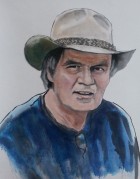
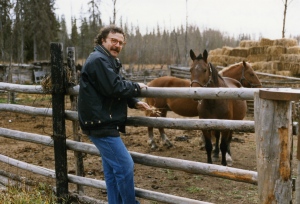
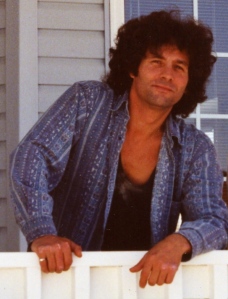
Second attempt to leave a comment, my computer mysteriously keeps shutting down.
This story makes my blood boil, just reading how elected members of the public behave. Goes to show who calls the shots when it comes to law in this country: big business. Perhaps we should just elect the CEO of a big corporation to run our country. At least we could save some money by cutting out the middle man.
I hope that the Idle No More movement continues to grow and gain momentum, perhaps it’s time all Canadians joined this movement and start having a voice. To some degree we are all victims of the Big Lie. As Canadian singer Stomping Tom put it in one of his songs, “there is no Canadian dream my friend.”
LikeLike
I remember when the Lubicon were all in the news and being so angry, and I recall they had never signed a treaty … but I did not know about all the underhanded dealings that went on.
You are a shit disturber of the right kind, Byron.
LikeLike
That was fantastic journalism on your part. You can see where our government is not only screwing the Lubicon, they are screwing everyone.
Where is this all going to end? We need to stand against corrupt government and people of greater power than us. The trouble is, we don’t know we’ve been screwed until it’s too late.
LikeLike
Great story and insights from the days of when getting out there and breaking a story mattered more than sitting on a chair re-writing wire copy. Still, I don’t see how Jenny Craig fits into this. Is she Native too?
LikeLike
This story is very entertaining but it is just that — a good story. It proves only that the Alberta and federal governments were ruthless in their dealings, and often in their treatment, of Indians who got in the way of their development plans — and of that we should not be proud. But it does not prove that the Lubicon Indians were unfairly treated under the law.
In the absence of signatures on a Peace Treaty, why are we required to assume that the Indians “owned” this land and its resources? What law in what court in what country at any time before or since determined that the Indians have primacy rights to claims on lands that have never had a deed of title written to them. The concept that Indians “own” any land that they did not legally cede away is bogus. Treaty 8 was a gift to many of Canada’s Indian bands but is not some inherent “right” that they have and that the rest of us must honor.
It is time all of us put this romanticized Indian narrative to bed for good. Canadians, including Native Canadians, have been manipulated by those with a vested interests in the “Indian industry” for decades and it needs to end, finally. The only people who gained are these self-serving power groups. For the rest of us, both White and Indian, it merely creates never-ending cycles of division and hostility between us.
LikeLike
I really enjoyed the read on the Lubicon protest. A must read for kids in journalism school.
LikeLike
@sharon
Before I went to jail in Peace River with the Lubicons during the events in 1988 described by Byron Christopher, I did see an oil industry raping Lubicon territory, I did notice Canadian politicians lying all over the place and a very willing police force. I did not see an “Indian industry”. I paid my airfare out of my personal pocket.
Following the events very closely ever since, I also take exception at your use of the past tense. Injustice does not become right just because it started a hundred years ago, if it continues to this day without being rectified. Among other things, it is this deliberate ahistorical attitude by a large number of Canadians that leads to the catastrophic condition on almost every reserve in Canada.
(I’ve seen a few…).
What I do see is that I went to jail in 1988 because of people like you.
Dionys Zink, AGIM Germany
LikeLike
The sad result of 400 years of Christian Canadians screwing them in a cultural sense. And even yet, they show a remarkable resilience.
When are we going to help instead of harvest our native neighbours?
LikeLike
Just happened onto your Lubicon blog … and was transported to a week in Little Buffalo 33 years ago.
I was hearing about the Lubicon Cree settlement on CBC, but didn’t hear the name Bernard Ominayak mentioned. So I went to Mr. Google to find out what had happened.
I had the privilege of visiting Bernard and Louise for five days, back in November, 1985. I was living in Olds, Alberta at the time, and was given a task to write a piece for the ELCiC (Lutheran Church), which was supportive of the Little Buffalo community. I flew up with a Lutheran pastor pilot and Fred Lennarson.
I got glimpses of what was going on … the inexplicable bribing of locals to sign onto the ”other” Lubicon community, etc.
One morning, while Chief Bernard was out helping a young family with their hot water heater, Fred Lennarson and I were lingering over a cup of strong tea, enjoying a full-blown argument (over the nature of evil, no less.) Louise Ominayak was sitting in a bedroom off to the side. Her 7-year-old ran over to her and asked her in Cree (she translated later for me), ”Mommy, why are they fighting?” She answered, with a smile, “They’re not fighting – white people always talk loud like that.”
Back to your blog … a great overview of the Lubicon story! Thank you for excellent writing, which put many bits into perspective for me.
Sad to know how rough life got for that family and that community over the years!
LikeLike
Thanks very much for this, was living in Alberta for part of it, but this fills in the shameful blanks in the story.
LikeLike